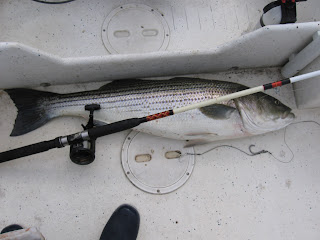
Striped Bass
I used to think nighttime was the right time for stripers but that’s not necessarily true.
In the early spring (late April-mid May) stripers are active pretty much all day. During this time daylight hours seem to be most productive. Cloudy, rainy, foggy, overcast days tend to be the best.
As the water warms up (mid May-end of June) these fish become more active in the evening or at the transitions from dawn and dusk. There is a real increase in feeding activity from sunrise into early morning and again at late afternoon till dark. For an hour after sunset there is usually an adjustment period where the action slows down then begins to pick up so if you were hitting fish at dusk and things slow down stick around and give it a shot a little later. After dark is also pretty productive at this time of year. One Night my friend Paul and I were pitching eels all night till dawn; we caught so many nice fish we didn’t want to stop. Mid day especially a sunny day is tough usually not much is happening. The exception is a cloudy overcast light rain and foggy day these days are productive all day. In the past few years I’ve come to believe dawn to early morning is the most productive time, the only problem is you have a very limited amount of time to locate the fish before things slow down.
During the summer months (July and August) striper fishing in general trickles down dramatically. Your only hope during the day is deep cool water usually outside of the bay or nighttime.
In the fall (Sept-Nov) the return migration begins and things go from evening fishing to any time of day as the water gets colder. Remember dawn to early morning and late afternoon to sunset there is an increase in feeding and tend to be more productive. Also overcast days tend to be better than sunny.
Blue Fish

Two things are important with blues, they are a warm water summer/fall fish and they are pretty much a daytime fish. You can get blues in June and July but the real big numbers are later in the summer. During the early months of June and July you can pick up blues here and there but they’re usually mixed in with bass. During this time of year you can catch them at night but usually only on live bait (eels, menhaden chunks etc…) they don’t usually like artificial lures at night. At night you usually you don’t get large numbers but the fish tend to be large 9-12lb range.
Blues tend to arrive in large numbers in mid August and stick around till October. Blues feed mostly during the day in big frenzied schools. From August-October and it’s not unusual to catch 75 or more in an afternoon. Cloudy days tend to be better but sunny days can also be pretty productive. The key to bluefish activity is a little chop and light to moderate wind, if it’s dead calm things can be tough. Even at this most productive time of year nighttime blue fishing is not very productive. Blues tend to be much less aggressive and concentrated at night. It’s not unusual to be surrounded by hundreds of feeding blues then once the sun goes down bang nothing. Like stripers however dawn to early morning and afternoon to sunset are the most productive. I personally think 3:00 pm till dark is the best time to blue fish.

















